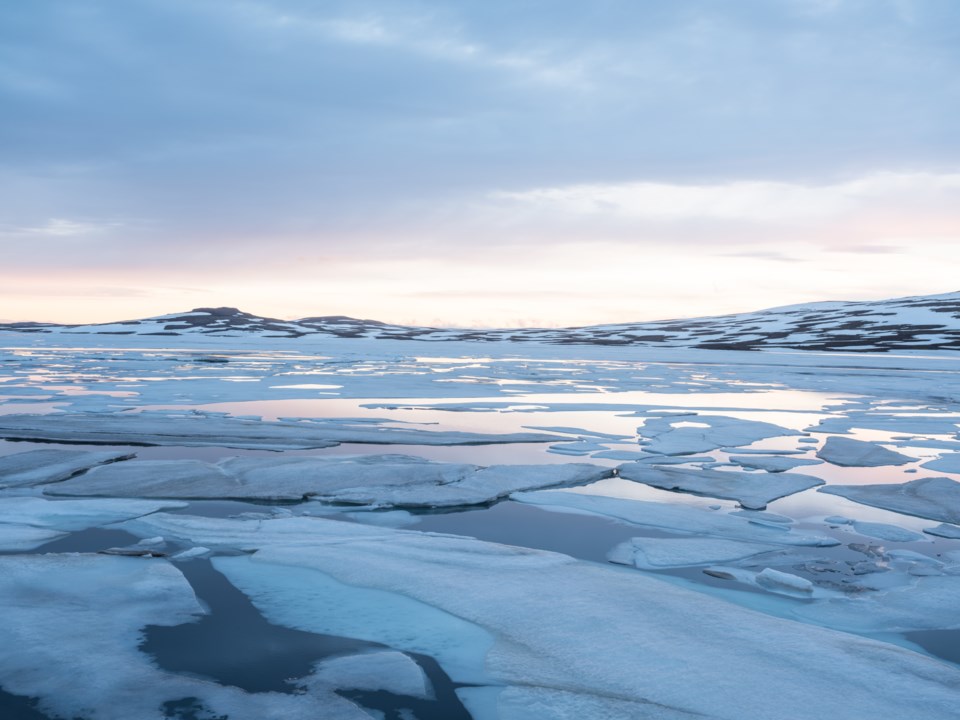Albedo is defined as the ability of a surface to reflect radiation.
Generally speaking, black has an abedo close to zero, absorbing almost all radiation, while pure white’s abedo approaches one, because it absorbs very little.
Of course, surfaces that absorb 100 per cent do not actually exist. However, fresh asphalt’s albedo of 0.04 (meaning it reflects just four per cent) comes close.
Likewise, surfaces that reflect 100 per cent don’t exist, either, but fresh fallen snow’s albedo of 0.9 (reflects 90 per cent) comes close. However, once snow becomes dirty, its albedo falls to 0.4 (it reflects 40 per cent).
You can see albedo at work every spring. You may have noticed that snow melts first around the base of trees. Sunlight warms the tree trunk. These re-radiate infrared — heat wavelengths, which are invisible to our eyes. This re-radiation warms the snow melting it early.
Once some bare ground appears, it begins to absorb sunlight, warming rapidly. This is termed “positive feedback,” meaning that the more bare ground is exposed (albedo 0.15), the more heat is absorbed and the faster the remaining snow melts.
I experienced this long ago when I went cross-country skiing for a week in Rovaniemi, Finland, north of the Arctic Circle. It was spring. When we arrived, the area was snow-covered.
By the third day, bare ground began to appear around tree trunks. By Day 5, these patches of bare ground expanded to merge with each other. At the end of the week, we were skiing on what resembled train tracks. The snow packed down by skiers was pretty much all that remained. It was time to pack up the skis and head south.
The reverse happens in winter. Initially, falling snow melts on the relatively warm ground. This bare ground continues to absorb warmth from the sun. As soon as the ground is snow-covered, heat absorption falls abruptly, allowing snow to accumulate rapidly – another positive feedback.
Many of us are watching the ice melt on Kempenfelt Bay. So long as the ice remains snow-covered, most of the sun’s warmth is reflected back into space. But, as soon as water is exposed, albedo falls to around 0.08, meaning that almost all of the sun’s energy (92 per cent) is absorbed by the water as heat.
Water doesn’t seem to warm up very quickly. That’s because the warm surface water mixes with deeper cold water; the deeper the water, the longer it takes to warm. Mind you, the reverse is also true. As winter begins, mixing delays freeze-up. Of course, the longer the water remains liquid, the more solar warmth it is able to absorb. This keeps the shore relatively warm, too. But as soon as the water freezes and that ice is snow-covered, the warming effect of the lake or ocean disappears.
On a planetary scale, albedo is important. Two hundred years ago, the Arctic Ocean was almost completely ice-covered year-round. That ice was largely snow-covered, reflecting almost all the solar radiation.
However, Arctic ice has been melting. Aside from the obvious effects on human Arctic populations, other arctic species such as polar bears have had trouble hunting as ice floes moved farther from land.
In 1980, there were 7.54 million square kilometres of Arctic ice. In 2000, 24 per cent of that had vanished. By 2020, that was down to half of the 1980 total.
You might wonder what difference that makes. If you live in a coastal Arctic community, the effects can be profound. Anchored to land, sea ice protects a shore from wave erosion. Melting leaves the shore exposed.
Some coastal Arctic communities have been forced to move two to three kilometres inland – buildings, roads, local electricity grid, sewage treatment facilities. Everything.
Farther inland, the winter freeze-up begins later and ends sooner. For communities that had relied on ice roads to haul in their annual supplies, the period of time during which they can use their ice roads has dramatically shortened.
A number of ice roads simply did not freeze up enough to be used by heavy trucks every winter. This forced communities, which had depended on them, to fly in supplies at great expense.
While we southerners may welcome shorter winters, this has always been the season when Inuit travelled. Solidly frozen terrain allowed isolated communities to travel safely for hunting, and for social interaction. Winter travel has become much less safe for Arctic peoples.
Leaving aside the effects on Arctic wildlife (polar bears, seals, walrus, etc.), ever larger expanses of open water have been absorbing solar radiation, putting the positive feedback process in motion. The more open water there is, the more heat is absorbed. This melts more ice, further shrinking ice cover.
In five months, my wife and I will board a small cruise ship that confidently expects to arrive at Pond Inlet, on the northwest coast of Baffin Island by Sept. 24. Members of Sir John Franklin’s ill-fated 1845 Arctic expedition would be astonished at how much ice the Arctic Ocean has lost.
It isn’t clear whether this loss of Arctic ice can be arrested. Once a positive feedback system has been set into motion, it can be difficult – perhaps impossible – to turn around.



